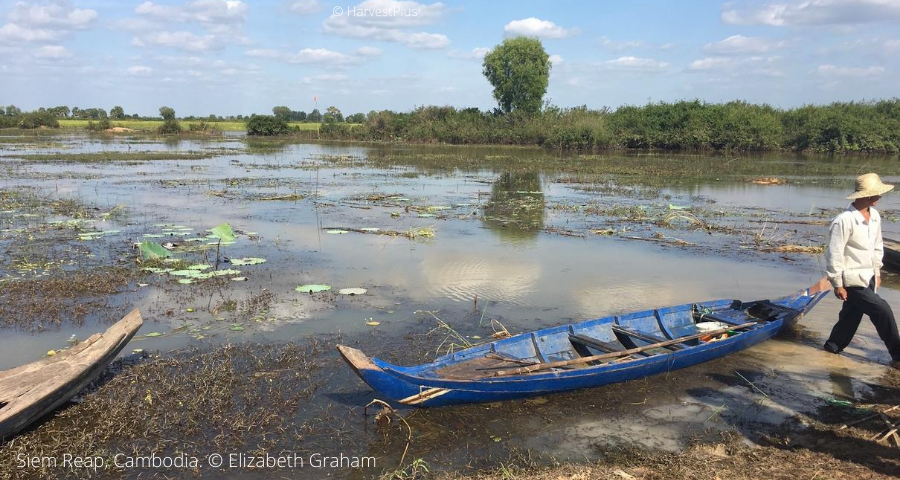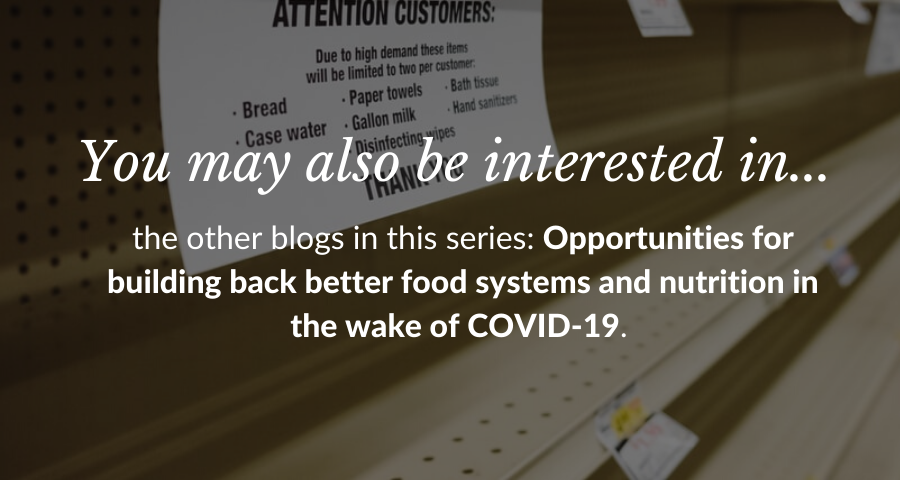As the world enters month seven of the COVID-19 pandemic, the impacts to agriculture and food systems have been a focal point, but effects on aquatic food systems have not gained as much attention. Seafood producers and consumers have been critically affected, and there will likely be long-term impacts to the nutritional status of populations, as well as lasting effects on aquatic food systems. As these effects reverberate throughout food systems globally, understanding them requires consideration of not only the importance of seafood to the diets and nutritional status of consumers in different parts of the world, but also of upstream drivers of aquatic food systems, including production and trade.
Background on seafood for nutrition and as a global commodity
Perspectives on the dietary role of fish are often shaped by cultural and economic factors. For Western consumers, seafood is often considered as a center-of-the-plate ‘protein’ and a luxury food eaten at restaurants. In the United States, for example, our recent paper showed that nearly two-thirds of seafood expenditures are made at restaurants and food service venues[1]. In many other parts of the world, however, seafood is primarily consumed in small amounts, given its high cost, but it fulfills a more important role for nutrition and food security[2]. The way seafood is processed, prepared and consumed also affects its nutritional properties. For example, breaded or fried fish has far fewer health benefits than baked fish[3], and consuming fish fillets without the head and bones, which are eaten in many parts of the world, means missing out on healthy fats, vitamins and minerals available in whole fish.
Production and trade are also critical elements of global food systems that affect seafood supply and availability. Seafood is a broad category that includes hundreds of species (or species groups) of fish, crustaceans, mollusks and aquatic plants[2]. About half of the global supply of aquatic animal sources is from fisheries (i.e., wild-caught) and half is from aquaculture (i.e., farm-raised) and is produced by a range of large-scale and small-scale actors. Inter-linkages among fisheries, aquaculture, and agriculture are common; for example, small wild-caught fish, feed crops, and oilseeds are turned into aquaculture feeds[4] . Over one-third of seafood is traded internationally[2] and while the diversity in seafood trade provides some measure of resilience, it also exposes vulnerabilities if countries are too reliant on a few trading partners[5]. For high-income countries, traceability, social responsibility, and environmental sustainability of seafood are top concerns, while food security is more important in low- and middle-income countries (LMICs)[6].
Early seafood-related impacts from COVID-19
China plays a key role in the production, consumption and trade of seafood. In 2018, it produced just over one-third of global aquaculture products[2], which was supported by imports of marine and terrestrial feed ingredients from around the world. Due to their outsized role in global seafood trade, and early exposure to COVID-19, China remains a key focal point of pandemic-related impacts to seafood. It was the first country to introduce lockdowns, which decreased consumer access to seafood and reduced both demand and trade. Early on, China banned imports of live animals, which subsequently stalled exports of live crustaceans from around the world. Its domestic seafood demand and trade have rebounded as the outbreak subsided there, and other parts of the world are now more affected.
Globally, fishing activity has decreased by 10% compared to the same time last year, and fishing activity is down by 50% or more in COVID-19 affected European countries[7]. In the aquaculture sector there are many examples of impacts, including reduced restocking of shrimp ponds across Southeast Asia, which will have lagged effects on supply[8]. Those whose livelihoods depend on the seafood sector (i.e., fishworkers) are also critically impacted. Many are now jobless or underemployed due to government lockdowns and curfews that limit their travel and the movement of goods. Migrant workers have also been stuck on fishing boats in India[9] and in ports in Thailand and Taiwan[10]. Several countries have applied the “essential worker” status to the seafood sector, which keeps fishworkers employed but at risk of getting sick.

Artisanal fishing and processing sectors in many countries have also been affected, which could accelerate a trend of decreased local access to nutrient-dense fish. In Senegal, small-scale enterprises, often led by women, have traditionally processed fish through smoking, salting, sun-drying and fermentation. The preserved fish are traded inland and even exported to neighboring countries including Mali, Burkina Faso and Côte D’Ivoire. Curfews put in place as a result of COVID-19 adversely affected both the availability of fish from small-scale fishers[11] as well as women’s ability to process the fish. Prior to COVID-19, the artisanal fishing and processing sector in Senegal was already under threat from foreign fishing trawlers and Chinese investment in the construction of more than 40 factories to process sardinella into fish meal and oil[12] (as described in an editorial from fisheries expert Daniel Pauly). Fish poaching and an expansion of licenses to foreign vessels have also led to a dwindling supply of fish for local processing[13]. While the factories must follow the same curfew restrictions, their ability to weather the restrictions is likely greater than women’s cooperatives ability to survive.
At the start of the pandemic in Kenya, there was speculation that rising prices, supply chain breaks and the stigma of fish from China might benefit the local aquaculture and fisheries sectors, which have struggled to compete with cheap imports of farmed tilapia from China[15]. However, local fishermen in Kenya have also suffered as dusk-to-dawn curfews force night fishers to work during the day, reducing their ability to catch fish[14]. Lower demand and lack of access to adequate refrigeration has also led to wastage rates as high as 70%[14]. COVID-19 may therefore accelerate processes already underway that ultimately lead to lower availability of fish in local markets and from imports, as well as shifts in employment patterns away from traditional fish processing. These types of power imbalances in seafood trade are now in much sharper contrast due to the pandemic and could have ramifications for nutrition and food security.
How do we ‘build forward better’?
In many countries, the seafood sector has been sidelined from mainstream discussions of nutrition and food security, while the agricultural sector has heavily participated in policy planning. For coastal countries and inland fisheries, this means tremendous resources have either been traded away or left out of efforts to find local solutions to nutritional deficiencies. A recent paper published in Nature found many countries could meet the entire micronutrient needs of their under-five populations if just 20% of their fish catch was consumed locally[17]. Fisheries policies in Western countries have also been slow to acknowledge the benefits of ‘fish as food’, and our work has found that correcting this bias will require shifts in how fisheries are managed[18].
The COVID-19 pandemic is illuminating inequities and accelerating existing trends in many sectors. The effects of the pandemic have also illustrated how central one country — China — is to both demand for fish and supply to many parts of the world. ‘Building forward better’ in the shadow of COVID-19 could translate into more purposive actions to quantify aquatic resources — thinking about how they are being used and reflect on how they could be used by local populations to address malnutrition and underemployment. Such discussions should include actors from fisheries and aquaculture sectors working alongside nutrition and food security policymakers. In the coming months and years, we urge the nutrition community to keep an eye on seafood production and trade, and how these might affect nutrition in LMICs on both an immediate and long-term basis.
The opinions expressed in this blog are those of the authors, but it also benefited from helpful discussions with an interdisciplinary team of seafood experts including Edward H. Allison, Frank Asche, Ben Belton, Richard S. Cottrell, Halley E. Froehlich, Jessica A. Gephart, Christina C. Hicks, David C. Little, Patricia Pinto da Silva, Florence Poulain, Angel Rubio, Joshua S. Stoll, Michael F. Tlusty, Max Troell, and Wenbo Zhang.
Dave Love is an Associate Scientist at the Johns Hopkins School of Public Health
Andrew Thorne-Lyman is an Associate Scientist at the Johns Hopkins School of Public Health
Liz Nussbaumer is a Project Director at the Johns Hopkins School of Public Health
Martin Bloem is a Professor at the Johns Hopkins School of Public Health and Director of the Center for a Livable Future
All are affiliated with the Johns Hopkins Center for a Livable Future (CLF), an academic center based within the Bloomberg School of Public Health.
References
- Love, D. C.; Asche, F.; Conrad, Z.; Young, R.; Harding, J.; Nussbaumer, E. M.; Thorne-Lyman, A. L.; Neff, R. Food Sources and Expenditures for Seafood in the United States. Nutrients 2020, 12 (6), 1810. https://doi.org/10.3390/nu12061810.
- SOFIA 2020 | FAO | Food and Agriculture Organization of the United Nations. https://doi.org/10.4060/ca9229en.
- Mozaffarian, D.; Lemaitre, R. N.; Kuller, L. H.; Burke, G. L.; Tracy, R. P.; Siscovick, D. S.; Cardiovascular Health Study. Cardiac Benefits of Fish Consumption May Depend on the Type of Fish Meal Consumed: The Cardiovascular Health Study. Circulation 2003, 107 (10), 1372–1377. https://doi.org/10.1161/01.cir.0000055315.79177.16.
- Linked sustainability challenges and trade-offs among fisheries, aquaculture and agriculture | Nature Ecology & Evolution https://www.nature.com/articles/s41559-017-0258-8?mc_cid=afc113a672&mc_… (accessed Jul 9, 2020).
- Kummu, M.; Kinnunen, P.; Lehikoinen, E.; Porkka, M.; Queiroz, C.; Röös, E.; Troell, M.; Weil, C. Interplay of Trade and Food System Resilience: Gains on Supply Diversity over Time at the Cost of Trade Independency. Glob. Food Secur. 2020, 24, 100360. https://doi.org/10.1016/j.gfs.2020.100360.
- Belton, B.; Reardon, T.; Zilberman, D. Sustainable Commoditization of Seafood. Nat. Sustain. 2020, 1–8. https://doi.org/10.1038/s41893-020-0540-7.
- Clavelle, T. Global Fisheries during COVID-19. Global Fishing Watch, 2020.
- Shrimp problems in Vietnam portend possible global shortage https://www.seafoodsource.com/news/supply-trade/shrimp-problems-in-viet… (accessed Jul 9, 2020).
- Fishing industry suffers another blow as workers are stranded on boats, debt is piling up https://theprint.in/india/fishing-industry-suffers-another-blow-as-work… (accessed Jul 9, 2020).
- Havice, E.; Marschke, M.; Vandergeest, P. Industrial Seafood Systems in the Immobilizing COVID-19 Moment. Agric. Hum. Values 2020. https://doi.org/10.1007/s10460-020-10117-6.
- COVID-19 Jeopardises the Artisanal Fish Supply and Trade in Senegal | Agrilinks https://www.agrilinks.org/post/covid-19-jeopardises-artisanal-fish-supp… (accessed Jul 9, 2020).
- How the global fish market contributes to human micronutrient deficiencies https://www.nature.com/articles/d41586-019-02810-2 (accessed Jul 9, 2020).
- We don’t need more fishing licences – we need help to fight COVID-19 - Greenpeace International https://www.greenpeace.org/international/story/43333/fishing-licences-s… (accessed Jul 9, 2020).
- Busia fishermen hit by Covid-19 impact https://www.the-star.co.ke/business/kenya/2020-06-29-busia-fishermen-hi… (accessed Jul 9, 2020).
- Could COVID-19 be a blessing in disguise for Kenyan aquaculture? https://thefishsite.com/articles/could-covid-19-be-a-blessing-in-disgui… (accessed Jul 9, 2020).
- African farmers struggle to compete with cheap Chinese tilapia https://thefishsite.com/articles/african-farmers-struggle-to-compete-wi… (accessed Jul 9, 2020).
- Harnessing global fisheries to tackle micronutrient deficiencies | Nature https://www.nature.com/articles/s41586-019-1592-6 (accessed Jul 9, 2020).
- Love, D. C.; Pinto da Silva, P.; Olson, J.; Fry, J. P.; Clay, P. M. Fisheries, Food, and Health in the USA: The Importance of Aligning Fisheries and Health Policies. Agric. Food Secur. 2017, 6 (1), 16. https://doi.org/10.1186/s40066-017-0093-9.
